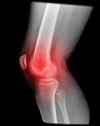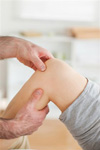What We Treat
Knee: Ligaments and Cartilage
The knee is the largest joint in the body. Its movement initially appears to be a simple hinge as it bends and straightens, however subtle spins, slides and glides between the joint surfaces make it a very complex joint.

It is a very unstable joint with the rounded end of the thigh bone (femur) sitting on the flattened top of the shin bone (tibia).
As a result the 4 ligaments around the knee are very important stabilising factors.
The cartilages (also called Menisci) sit between the thigh bone and shin bone, helping the way they fit together as well as acting as shock absorbers.
The Collateral ligaments (medial and lateral) lie one either side of the knee or limit angulation movements.
The Cruciate ligaments (anterior and posterior) are inside the joint and limit the front to back movement of the thigh on the shin.
All the ligaments limit rotation of the joint, which is why a rotational injury, such as those often sustained when skiing or playing football can cause so much damage.

A combined injury to the Anterior Cruciate, Medial Collateral Ligament and Medial Meniscus is known as the Unhappy Triad. This is a major injury and affected Paul Gascoigne in the 1991 FA Cup final.
Ligamentous sprains can be treated effectively with physiotherapy, helping them to repair strongly and so reducing the risk of them becoming a recurring problem.
Major ligament ruptures, especially that of the Anterior Cruciate Ligament (or ACL) will usually need surgical intervention, followed by a lengthy period of post operative rehabilitation to regain movement, strength and function.
The cartilage can also be damaged by a rotational injury. It becomes trapped between the thigh bone and shin bone then the twisting movement causes a tear in its structure. This can form a little flap of tissue which at times can obstruct the joint causing it to lock.
The cartilage also degenerates as we age and can become worn around the edge, often causing pain and ‘clicking’ in the joint.
As the cartilage has a very poor blood supply it does not repair itself at all well and so surgical intervention is usually necessary for these problems, again followed by a period of post operative rehabilitation.


